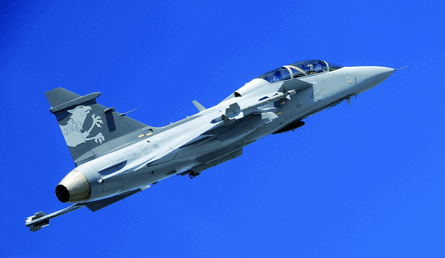Patience is a virtue in the business of selling fighter jets. Hungary's decision to take 14 JAS39 Gripens (becoming the type's first NATO customer) followed a competition that lasted 12 years. Now Gripen International is entering a critical and potentially highly lucrative phase, with major order decisions imminent in Norway, Switzerland and India - where it has laid years of groundwork.
Switzerland is looking to replace Northrop F-5Es, and as such it falls into the most challenging of the three sales-target categories identified by Gripen. The others are NATO members seeking to replace Soviet aircraft and non-aligned companies looking to migrate from Dassault Mirages and Sepecat Jaguars. However, a favourable outcome for Gripen would not be unprecedented - in October 2007 Thailand ordered six Gripens to replace F-5Es. A Swiss win would be more lucrative, with 33 aircraft mooted. The final decision is expected in July 2009. Gripen jets have already completed flying evaluations as part of the competition, which also involves the Dassault Rafale and Eurofighter Typhoon.
 |
|---|
© Saab |
A yet more lucrative prize lies in the non-aligned customer category, where India is due to decide in 2010 on a 126-aircraft order with a 50% offset requirement. Here, the Gripen competes with the Boeing F/A-18E/F, Dassault Rafale, Eurofighter Typhoon, Lockheed Martin F-16 and the RSK MiG-35. "India will be a global superpower within 25 years," says Gripen chief executive Johan Lehander, "and they are looking for independence. Gripen could be one way to do it. You don't have to sign up with Russia. You don't have to sign up with the USA." Lehander characterises the Indian order as complex and tough to win. "Everyone is there," he says. "It will take time, but we think we are in a good position and have done a good job so far."
In the nearer term, some decisions are expected closer to home. By year-end Norway is expected to choose the destination of a 48-aircraft order, and Gripen's position in a two-horse race with the Joint Strike Fighter appears strong in light of the Norwegian government's part-financing of the demonstrator programme, and in the context of strengthening political ties within the Nordic region, typified by the work of the Nordic Battle Group. Yet Norway is a partner in the JSF, so a Gripen victory would be a major coup. Denmark is also contemplating a 48-aircraft order, and Gripen has bid.
UPGRADES
While various sales campaigns come to a head and another is launched in Brazil, the manufacturer is continuing to hone its Gripen Demonstrator, intended as a bridge to the next- generation version of the fighter. The Phase I version of the aircraft, now in flight test, incorporates a new landing gear and weapons pylons, plus a General Electric F414G engine. Phase II upgrades will include a new modular avionics system, using layers and partitions to isolate system components and separate flight-critical from mission functions. There are also plans to include increased internal fuel capacity and a 1,700 litre (450USgal) external fuel tank, integration of small diameter bombs, enhanced satellite communications and a broadband datalink, an active electronically scanned array radar and missile approach warners.
"We are small - small company, small country," says Lehander. "Our advantage is that the key technology in Gripen, we control ourselves. To grow, we need to develop partnerships, and we are prepared to share everything we have. We can't keep things to ourselves. We are too small for that."
At the macro level, Gripen has forecast that while 5,000 fighters will "need" to be replaced over the next 10 years, only 2,500 will be, and it is aiming for a 10% share of the market. As it seeks to add to export customers including South Africa (26 units), NATO members Hungary (14) and the Czech Republic (14), and Thailand (six), Gripen emphasises cost efficiency. "It's hard to compete on price with ourselves," says Lehander, who considers Gripen's marketing strategy to be less aggressive than certain competitors'. "When we work on the market, we promote Gripen, not talk about our competitors. I don't think our competitors have realised that is a good tactic."
Lehander adds that, as a slow and painstaking process, selling fighter jets is not like selling mobile phones. For Gripen, the hope is that patience may soon get its reward.
Source: Flight International























